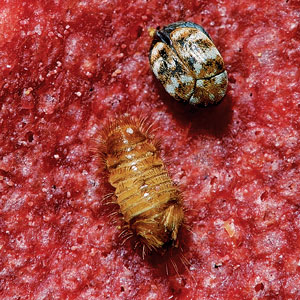
Photo: courtesy of, and copyrighted by, Gene White, pmimages@earthlink.net
Question: I am relatively new to the industry, and I am having some difficulty at a client’s facility with what looks like carpet beetles. The facility only has vinyl, tile and concrete floors. What else could they be?
— B. Fuddled
Answer: What else could they be? Well, that I can’t answer, but they certainly could be carpet beetles. The term carpet beetle comprises several members of the dermestid family that feed on items made from animal materials like hides and hair. Carpets used to be made from wool and other natural fibers, and carpet pads were made from cattle hair, both of which provided plenty of food for these beetles in our homes, and the name stuck.
A few years ago, a good friend called me about a carpet beetle problem at a local museum. It was not an uncommon situation, nor was it an easy one to resolve. The problem isn’t that the pest is difficult to eliminate, it’s with the level of care that is needed with the articles that are being damaged. In a commercial setting, carpet beetle infestations often involve items that have significant value that your client needs to save. In the museum’s case, some of the artifacts were old and very delicate. You must be sensitive to all your client’s needs when resolving any pest issue; you can’t just focus on eliminating the pest.
As always, make sure you accurately identify the pest. For your question, B., let’s assume you are dealing with the varied carpet beetle (Anthrenus verbasci). Now what?
The first thing to remember is that it’s the larvae of this species — and of other carpet beetles, too — that causes damage to fabrics, not the adults. Adults feed on pollen and often are found on flowering plants both inside and outside. If you are only finding adult beetles, with no sanitation concerns or evidence of product damage, you may want to consider an inspection and pheromone monitoring program as a first step. A call to your distribution representative can help you get in contact with a manufacturer that can help guide you through some options.
If you see, or your client reports damage, much of your work will involve painstakingly inspecting for areas of activity. You’re looking primarily for damaged clothing or other natural materials.
After finding and removing any damaged items with your cooperative client, your focus needs to be on extensive vacuuming. Any place that animal or human dander and hair can collect must be thoroughly vacuumed to remove larvae and food sources. This includes floor/wall junctions, ducts, vents, and under and around floor-level equipment.
Once any infested items are removed and the areas are cleaned, you may treat cracks and crevices with an appropriately labeled residual insecticide. You also should implement an extensive visual inspection and pheromone monitoring program to maintain a pest-free environment.
Keep in mind that infested items do not necessarily need to be discarded. Rugs, valuable pieces, and similar items can be treated and saved. If your client determines the infested product isn’t damaged, options are available, including heat treatments and fumigation.
Email your questions about insect identification and pest management technologies to pmpeditor@northcoastmedia.net. Your questions most likely will be printed and answered in one of Pest Management Professional’s upcoming columns.
The post Look beyond carpets for this beetle appeared first on Pest Management Professional.
No comments:
Post a Comment